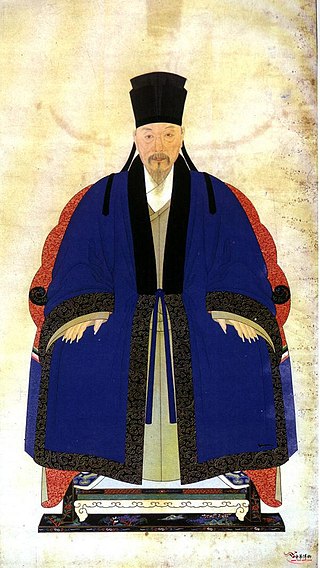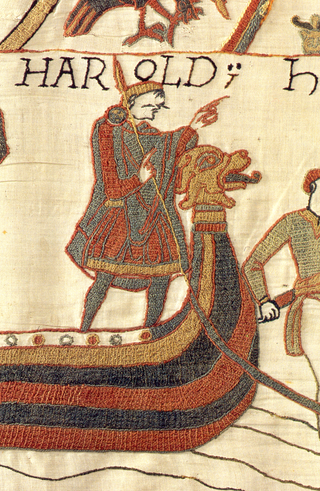
Cheongsam or zansae, also known as the qipao and sometimes referred to as the mandarin gown, is a Chinese dress worn by women which takes inspiration from the qizhuang, the ethnic clothing of the Manchu people. The cheongsam is most often seen as a longer, figure-fitting, one piece garment with a standing collar, an asymmetric, left-over-right opening and two side slits, and embellished with Chinese frog fasteners on the lapel and the collar. It was developed in the 1920s and evolved in shapes and design over years. It was popular in China from the 1920s to 1960s, overlapping with the Republican era, and was popularized by Chinese socialites and high society women in Shanghai. Although the cheongsam is sometimes seen as traditional Chinese clothing, the cheongsam continues to evolve with times as it responds to the contemporary modern life.

A kurta is a loose collarless shirt or tunic worn in many regions of South Asia, and now also worn around the world. Tracing its roots to Central Asian nomadic tunics, or upper body garments, of the late-ancient- or early-medieval era, the kurta has evolved stylistically over the centuries, especially in South Asia, as a garment for everyday wear as well as for formal occasions.

A folk costume expresses a national identity through clothing or costume, which is usually associated with a specific region or period of time in history. It can also indicate social, marital, or religious status. If the costume is used to represent the culture or identity of a specific ethnic group, it is usually known as ethnic costume. Such costumes often come in two forms: one for everyday occasions, the other for traditional festivals and formal wear. The word "costume" in this context is sometimes considered pejorative due to the multiple senses of the word, and in such cases "clothing", "garments" or "regalia" can be substituted without offense.

Áo dài is a modernized Vietnamese national garment consisting of a long split tunic worn over silk trousers. It can serve as formalwear for both men and women. Áo translates as shirt and dài means "long". The term can also be used to describe any clothing attire that consists of a long tunic, such as nhật bình.

A chiton is a form of tunic that fastens at the shoulder, worn by men and women of ancient Greece and Rome. There are two forms of chiton: the Doric and the later Ionic. According to Herodotus, popular legend was that Athenian women began to wear the chiton as opposed to the peplos after several women stabbed a messenger to death with the bronze pins characteristic of the peplos.

A himation was a type of clothing, a mantle or wrap worn by ancient Greek men and women from the Archaic period through the Hellenistic period. It was usually worn over a chiton and/or peplos, but was made of heavier drape and played the role of a cloak or shawl. When the himation was used alone, without a chiton, it served both as a chiton and as a cloak. The himation was markedly less voluminous than the Roman toga. Many vase paintings depict women wearing a himation as a veil covering their faces.

Vietnamese clothing is the traditional style of clothing worn in Vietnam by the Vietnamese people. The traditional style has both indigenous and foreign elements due to the diverse cultural exchanges during the history of Vietnam. This all eventually led to the birth of a distinctive Vietnamese style of clothing, including the birth of the unofficial national dress of Vietnam, the áo dài.

Clothing in ancient Rome generally comprised a short-sleeved or sleeveless, knee-length tunic for men and boys, and a longer, usually sleeved tunic for women and girls. On formal occasions, adult male citizens could wear a woolen toga, draped over their tunic, and married citizen women wore a woolen mantle, known as a palla, over a stola, a simple, long-sleeved, voluminous garment that modestly hung to cover the feet. Clothing, footwear and accoutrements identified gender, status, rank and social class. This was especially apparent in the distinctive, privileged official dress of magistrates, priesthoods and the military.

The preservation of fabric fibers and leathers allows for insights into the attire of ancient societies. The clothing used in the ancient world reflects the technologies that these peoples mastered. In many cultures, clothing indicated the social status of various members of society.

Áo bà ba is a traditional southern Vietnamese garment. The top part which covers the torso is called the áo. It is mostly associated with rural southern Vietnam, especially in the Mekong Delta. Often worn as a top and bottom set, the áo bà ba is typically a long-sleeved, button-down silk shirt with a scooped neck, paired with silk pants. The shirt is long and split at the waist sides, forming two flaps customarily with two pockets.

Beizi, also known as beizi and chuozi, is an item worn in traditional Chinese attire common to both men and women; it is typically a large loose outer coat with loose and long sleeves. It was most popular during the Song dynasty, Ming dynasty, and from the early Qing to the Mid-Qing dynasty. The beizi originated in the Song dynasty. In the Ming dynasty, the beizi was referred as pifeng. When worn by men, it is sometimes referred as changyi, hechang, or dachang when it features large sleeves and knotted ties at the front as a garment closure.

Anglo-Saxon dress refers to the clothing and accessories worn by the Anglo-Saxons from the middle of the second century to the eleventh century. Archaeological finds in Anglo-Saxon cemeteries have provided the best source of information on Anglo-Saxon costume. It is possible to reconstruct Anglo-Saxon dress using archaeological evidence combined with Anglo-Saxon and European art, writing and literature of the period. Archaeological finds have both supported and contradicted the characteristic Anglo-Saxon costume as illustrated and described by these contemporary sources.

Early medieval European dress, from about 400 AD to 1100 AD, changed very gradually. The main feature of the period was the meeting of late Roman costume with that of the invading peoples who moved into Europe over this period. For a period of several centuries, people in many countries dressed differently depending on whether they identified with the old Romanised population, or the new populations such as Franks, Anglo-Saxons, Visigoths. The most easily recognisable difference between the two groups was in male costume, where the invading peoples generally wore short tunics, with belts, and visible trousers, hose or leggings. The Romanised populations, and the Church, remained faithful to the longer tunics of Roman formal costume, coming below the knee, and often to the ankles. By the end of the period, these distinctions had finally disappeared, and Roman dress forms remained mainly as special styles of clothing for the clergy – the vestments that have changed relatively little up to the present day.

A yếm or áo yếm is a traditional Vietnamese undergarment that was once worn by Vietnamese women across all classes. It was most usually worn underneath a blouse or mantle to preserve modesty.

Clothing in ancient Greece refers to clothing starting from the Aegean bronze age to the Hellenistic period. Clothing in ancient Greece included a wide variety of styles but primarily consisted of the chiton, peplos, himation, and chlamys. Ancient Greek civilians typically wore two pieces of clothing draped about the body: an undergarment and a cloak. The people of ancient Greece had many factors that determined what they wore and when they wore it.
The Medieval period in England is usually classified as the time between the fall of the Roman Empire to the beginning of the Renaissance, roughly the years AD 410–1485. For various peoples living in England, the Anglo-Saxons, Anglo-Danes, Normans and Britons, clothing in the medieval era differed widely for men and women as well as for different classes in the social hierarchy. The general styles of Early medieval European dress were shared in England. In the later part of the period, men's clothing changed much more rapidly than women's styles. Clothes were very expensive and both the men and women of lower social classes continued also divided social classes by regulating the colors and styles these various ranks were permitted to wear. In the early Middle Ages, clothing was typically simple and, particularly in the case of lower-class peoples, served only basic utilitarian functions such as modesty and protection from the elements. As time went on the advent of more advanced textile techniques and increased international relations, clothing gradually got more and more intricate and elegant, even with those under the wealthy classes, up into the renaissance.

Shalwar kameez is a traditional combination dress worn by men and women in South Asia, and Central Asia.

The clothing of the people in biblical times was made from wool, linen, animal skins, and perhaps silk. Most events in the Hebrew Bible and New Testament take place in ancient Israel, and thus most biblical clothing is ancient Hebrew clothing. They wore underwear and cloth skirts.

The áo giao lĩnh, referred to as the giao lãnh y in Literary Chinese texts. Folk often call it áo tràng vạt or áo tràng xiên, referred to as áo tràng, was a traditional cross-collared robe worn by Vietnamese before the 19th century. It was influenced from Han Chinese clothing and was typically worn by the royalty, the aristocracy, the nobility, and the commoners. During the Nguyễn dynasty, the áo ngũ thân was commonly worn and the áo giao lĩnh was only worn in formal occasions.

Shanku is a generic term which refers to a two-piece set of attire in Hanfu, which is typically composed of a youren yi, a Chinese upper garment which typically overlaps and closes on the right side which could be called shan, ru, ao, and a pair of long trousers ku. As a form of daily attire, the shanku was mainly worn by people from lower social status in China, such as labourers, shopkeepers, or retainers from wealthy household. The shanku was originally worn by both genders. Up until the mid-20th century, it was popular in China and outside of China where it was worn by overseas Chinese in countries, such as Singapore, Malaysia, Suriname, etc. It is still worn in present-day China and can be found in rural areas.






















